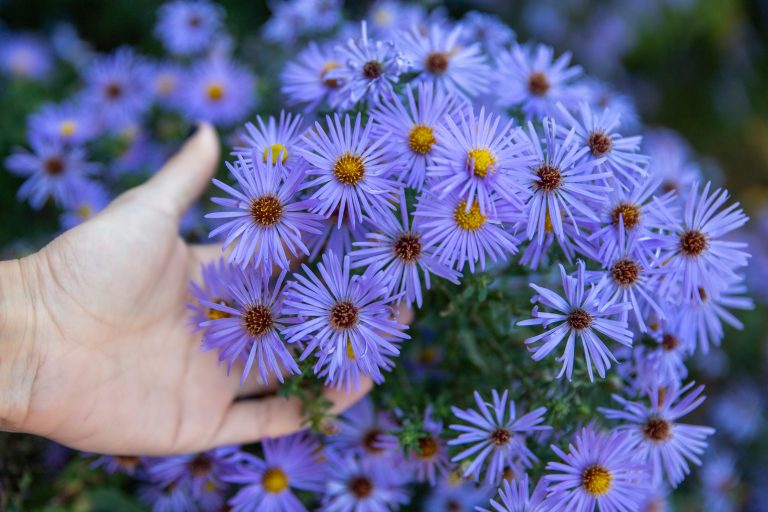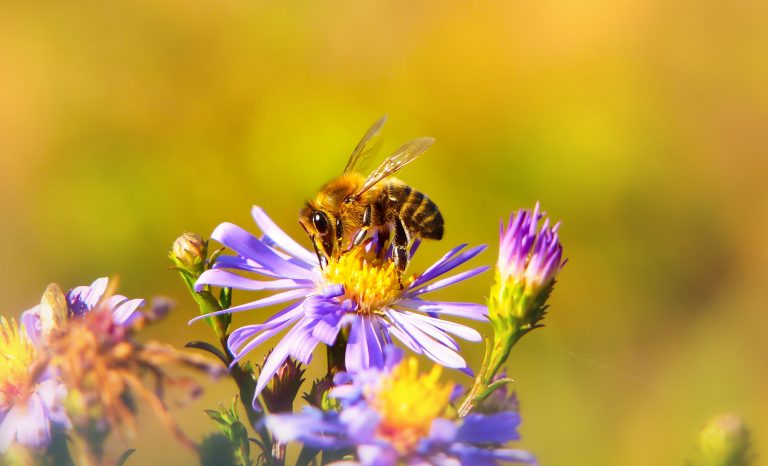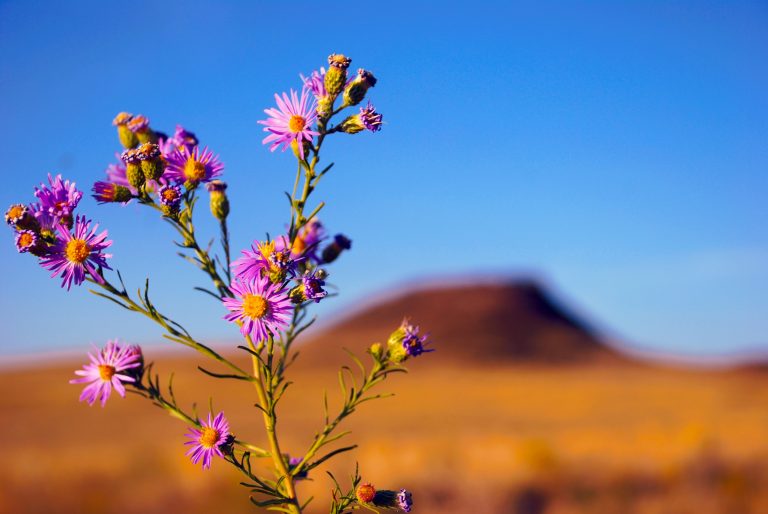Growing an aster flowers can be an excellent addition to your garden and comes in a wide variety. Their vibrant colours add a lovely pop to any environment, and they’re great border plants for landscaping.
Growing these purple flowers is relatively straightforward, but knowing what to do to help them reach their full potential is key.
Let’s take a closer look at everything you need to know about aster, how to plant it and how to take care of it.
Jump To a Section Below
What Is An Aster Flower?

Asters are small, dainty daisy-like flowers. They are perennials and feature star-shaped flower heads that range in colour from white to purple, although the latter is more commonly found. The centre of the flower is bright yellow. They add a touch of delight to almost every garden come summertime.
How To Grow Asters
As mentioned, growing aster flowers is quite easy. However, to ensure they bloom at their best, keep in mind the following factors:
Where to Plant Asters
Asters prefer cooler climates and moist summers with cool night temperatures. However, if you live in a warmer climate, simply plant your asters in an area away from the midday sun. The soil you plant your aster in should be well-drained.
When to Plant Asters
The best time for you to plant your asters is in mid – to late spring. However, if you are planning to keep your asters potted, you can plant them as soon as they become available, which is usually in autumn.
How to Plant Asters
Be sure to plant your asters between one and three feet apart, depending on the variety of asters you have and how big you expect them to get. Sow the seeds at least one inch deep in the soil and if you are potting them, place them in a sunny location. If you’re planting young plants, be sure to move them outside only once the danger of frost has passed.
How to Care for Asters

Asters are low maintenance, but they do need the right amount of water.
If your area receives less than one inch of rain a week, remember to water them regularly during the summer months. However, many asters are quite sensitive to moisture. If they have too much moisture or even too little, they run the risk of losing their foliage and not flowering well. If you notice that your aster plants are losing flowers, try a different method of watering.
At the start of summer, pinch your asters back once or twice to promote bushier growth and more blooms. In terms of further pruning, cut your asters back in winter once all the foliage has died.
Remember that flowers that are left to fully mature typically reseed themselves. However, the asters that grow from this may not be a true bloom, which means that your new asters may not be the same colour as the ones you originally planted.
Do Asters Come Back Every Year?
Asters that are planted during spring will typically bloom in the autumn months. Asters will more than likely return the following year as they will self-seed if left to fully mature.
How Long Do Asters Last?
There are two popular variants of aster, namely the New England aster and the New York aster. They can be difficult to tell apart, but the New England aster usually enjoys dense, full flowers that bloom in the later months of summer or early in autumn. These last for several weeks.
On the other hand, New England aster has thinner stems and smoother leaves and will last for a few weeks.
Will Asters Spread?
All asters have the potential to spread. They are rambunctious plants that spread by underground rhizomes. While they make for excellent ground cover and very rarely cause any real problems in the garden, they can occasionally become quite weedy.
Can Asters Grow In Pots?
Aster plants can grow just fine in pots, but you need to find one of an appropriate size. There are two obstacles to consider. For one, you need a pot that has plenty of space for the roots to grow. On the other hand, any overly large containers may hold excess water which could lead to root rot.
Another option is to plant your asters in the pots that you have. Once it starts outgrowing the pot, you can always transfer it to a bigger pot or plant it in the ground.
Are Asters Toxic To Dogs?
For many gardeners, pets need to be taken into consideration when they choose which plants to grow. Aster flowers eliminate the stress of needing to keep your dogs away from the plant as they are considered to be non-toxic to our canine companions.
Do Bees Like Asters?
Bees love aster flowers and are attracted to the yellow centre of the plant. Asters provide a valuable late-season source of nectar for both bees and butterflies.
Are Asters The Same As Mums?
Chrysanthemums, the flower associated with 13th wedding anniversaries, are also known as mums. Mums include over 200 species of the aster family. Technically, this means that all mums are asters but not all asters are mums!
Both of their bloom cycles are triggered by the shortening length of daylight hours, which is why both plants naturally bloom in autumn.
What is the Meaning of Aster Flower

Like many flowers, asters have their own special meaning. In general, the flower is representative of love, wisdom and faith.
Back in the Victorian era, asters represented daintiness, patience and a sense of calm. When burnt, the odour that the flower emitted was believed to ward off serpents.
If you love pretty purple flowers, add some asters to your garden. Our guide shows you just how easy they are to grow.
Fun fact: aster is also the official flower for the month of September. If you’re not a September baby but want to know what your birth flower is, check out the full list of birth month flowers.

Lily’s love for flowers and plants was nurtured in her grandmother’s vibrant garden. Over the years, this affection blossomed into a full-fledged passion for horticulture.
With formal training in botany and countless hours in her own backyard oasis, Lily has cultivated a deep understanding of plant care and garden design.